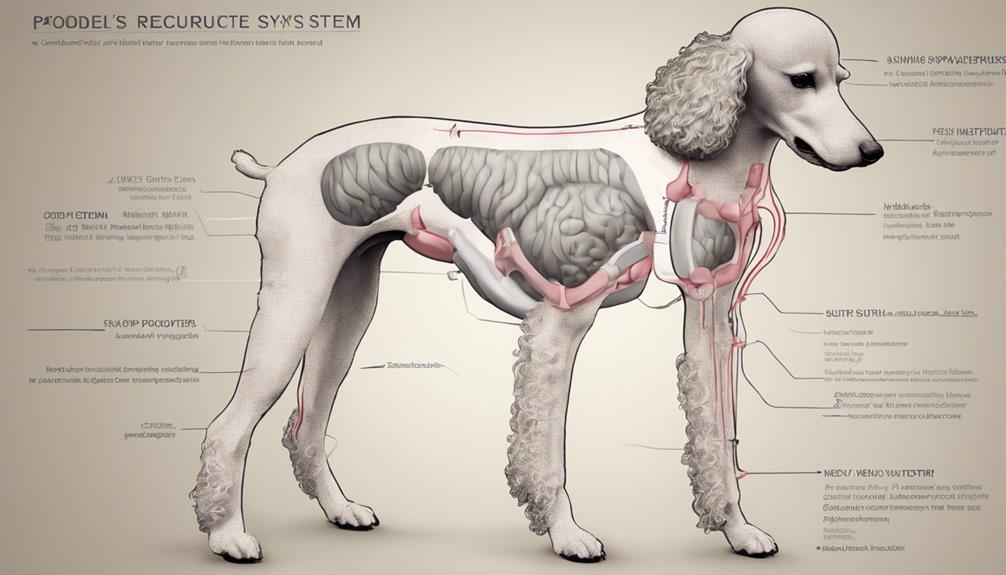If you're concerned about the potential risks of spaying or neutering your poodle, rest assured that there are significant health benefits to consider. These procedures play a crucial role in not only preventing unwanted litters but also promoting a longer and healthier life for your furry companion. However, before making a decision, it's essential to weigh the pros and cons carefully. So, what exactly are the specific health advantages and considerations you should keep in mind when it comes to spaying and neutering your poodle? Stay tuned to find out more about how these procedures can impact your pet's well-being.
Key Takeaways
- Spaying and neutering reduce cancer risks and prevent reproductive health issues in Poodles.
- Behavioral improvements include reduced aggression, better sociability, and curbing mating behaviors.
- Neutering prevents prostate problems and enhances behavior in Poodles if done before puberty.
- Prevent health issues, improve behavior, and promote well-being by spaying or neutering Poodles.
Health Benefits of Spaying Poodles

Spaying female poodles offers a range of significant health benefits that contribute to their overall well-being and longevity. By spaying your poodle, you can greatly reduce the risk of ovarian, uterine, and mammary cancers. This procedure eliminates the possibility of pyometra, a severe infection of the uterus, which can be life-threatening if left untreated. Additionally, spaying helps prevent unwanted pregnancies that can pose health risks to both the mother and the puppies.
Moreover, spaying your poodle can decrease hormone-driven behaviors such as aggression and excessive territorial marking. These behaviors can not only be challenging to manage but also impact the overall quality of life for your pet. By opting for spaying, you are not only promoting your poodle's physical health but also their mental well-being.
Importance of Neutering Poodles

Neutering your male Poodle is crucial for preventing various health issues like prostate disease. It can also significantly improve behavior and temperament by reducing territorial marking and the urge to run away. Consider neutering your Poodle before they reach puberty, typically around 4-6 months old, for the best outcomes in their health and behavior.
Preventing Health Issues
To maintain the health and well-being of your male Poodle, consider the benefits of neutering to prevent various potential health issues. Neutering male Poodles reduces the risk of prostate disease, eliminates marking issues, and curbs roaming behavior. It also helps in maintaining a healthy weight, reducing the chances of obesity-related problems. By neutering your male Poodle, you can eliminate the risk of testicular cancer and contribute to a longer, healthier lifespan. Check out the table below for a quick overview of the health benefits of neutering your male Poodle:
| Health Benefits of Neutering Male Poodles |
|---|
| Reduces risk of prostate disease |
| Prevents marking issues |
| Decreases roaming behavior |
| Helps maintain a healthy weight |
| Eliminates risk of testicular cancer |
Behavior and Temperament
By neutering your male Poodle, you can positively influence their behavior and temperament, leading to a more balanced and sociable companion. Neutering can reduce territorial marking and aggression towards other dogs, making interactions with pets and people more pleasant. It also helps in curbing roaming tendencies, decreasing the likelihood of your Poodle getting lost or into fights. Neutered Poodles are less likely to display mating-related behaviors like mounting, resulting in a more relaxed household environment. Additionally, the procedure can contribute to a more stable temperament, promoting improved social interactions and reducing dominant behaviors in male Poodles. Overall, neutering your male Poodle not only benefits their individual well-being but also enhances their role as a cherished member of your family.
Considerations for Spaying Poodles

Consider spaying your female Poodle before her first heat cycle to greatly reduce the risk of mammary cancer. This procedure, recommended at 3-4 months of age, can have significant health benefits for your furry companion. Spaying not only decreases the chances of mammary cancer but also eliminates the risk of uterine infections and unwanted litters.
When contemplating spaying your Poodle, it is essential to discuss the optimal timing with your veterinarian, considering factors like growth plate concerns. By addressing these considerations, you can ensure the procedure is performed at the most suitable time for your pet's overall health and well-being.
Spaying your female Poodle is a responsible choice that can positively impact her quality of life. It not only helps prevent serious health issues but also contributes to controlling the pet population. By taking this step, you are actively promoting the long-term health and happiness of your beloved Poodle.
Health Risks of Neutering Poodles

When considering the health risks associated with neutering Poodles, it's important to be aware of potential impacts on bone development, incontinence in females, and increased risks of certain cancers for males. Neutering can slightly delay the closure of growth plates in poodles, potentially affecting their bone development. Neutered female poodles may face a risk of incontinence, while neutered males have an elevated chance of developing cardiac tumors and specific cancers. Although the benefits of neutering often outweigh the risks, it's crucial to take individual health factors into account when deciding whether to neuter your poodle. While some poodles may experience a delay in growth plate closure post-neutering, understanding the risks versus benefits and considering these factors thoughtfully is essential in making an informed decision about your poodle's health and well-being.
Timing of Spaying or Neutering

To maximize the health benefits for female Poodles, spaying ideally occurs before their first heat cycle, typically around 3-4 months of age. This timing is crucial as spaying before the first heat greatly reduces the risk of certain reproductive cancers and infections, providing long-term health advantages for your furry companion. For male Poodles, neutering before puberty, around 4-6 months old, can also help prevent potential health issues. Waiting until 6-9 months to spay or neuter Poodles can address concerns about growth plate closure and development, ensuring their overall well-being. The spaying procedure for female Poodles involves the removal of the ovaries and uterus under general anesthesia, while neutering male Poodles includes the removal of testicles. By following these timing guidelines for spaying or neutering your Poodle, you are actively promoting their health and longevity, a decision that can benefit both you and your beloved pet.
Poodle-Specific Spaying and Neutering Guidelines

For optimal health outcomes in Poodles, adhering to specific spaying and neutering guidelines tailored to this breed is essential. Female Poodles should be spayed before their first heat cycle, typically around 3-4 months old. This timing helps reduce the risk of mammary cancer and pyometra. On the other hand, male Poodles should be neutered before reaching puberty, usually around 4-6 months old, to decrease the chances of prostate disease and territorial marking behaviors. However, considering the growth plate concerns in Poodles, it is advisable to wait until they are 6-9 months old for spaying or neutering to avoid potential developmental issues. Spaying involves the removal of ovaries and uterus under general anesthesia, with internal and external stitches for female Poodles. Neutering male Poodles includes an incision in the scrotum to remove testicles, tying off blood vessels, and using dissolvable or removable stitches after 10 days. Following these guidelines can promote the overall well-being of your beloved Poodle.
Frequently Asked Questions
What Are the Considerations and Advantages of Spaying or Neutering Your Dog?
When considering spaying or neutering your dog, you benefit from behavioral changes, weight management, cancer prevention, and heat cycle regulation. These procedures also help with overpopulation control, hormone regulation, longevity benefits, and urinary issues while imposing breeding restrictions and some surgical risks.
What Are the Positive and Negative Effects of Spaying and Neutering?
When spaying or neutering your pet, positive effects include improved behavior and reproductive health, balanced hormones, weight management, and prevention of overpopulation. Consider long-term effects, surgical risks, recovery time, and follow veterinary recommendations based on age.
Are Spayed and Neutered Dogs Healthier?
Spayed and neutered dogs are healthier with increased longevity, reduced disease risks, and better hormonal balance. This preventative care choice offers benefits such as weight management, behavioral improvements, and aids in population control, outweighing surgery risks and costs.
What Is the Best Age to Spay a Standard Poodle?
For the best age to spay a standard poodle, consult your vet. Spaying early, before the first heat, offers growth development benefits, regulates hormones, prevents pregnancies, reduces health risks, and aids in cancer prevention. Trust professional veterinary recommendations for long-term benefits.
Conclusion
In conclusion, spaying and neutering your poodle not only helps prevent unplanned litters and contribute to reducing pet overpopulation but also provides numerous health benefits like preventing diseases and behavioral issues. Remember, "An ounce of prevention is worth a pound of cure." So, consult with your veterinarian to determine the best timing for these procedures and ensure the long-term health and well-being of your beloved poodle.
